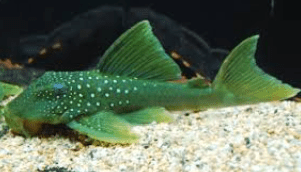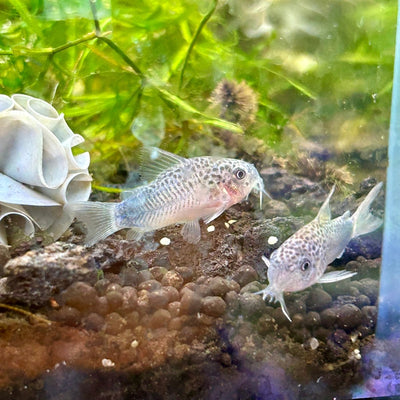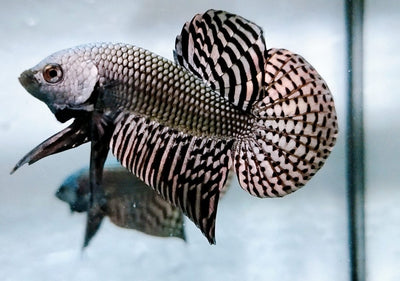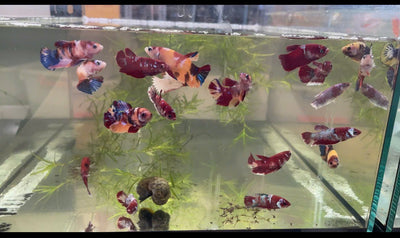Breeding bettas (also known as Siamese fighting fish) can be a fascinating and rewarding process, but it requires careful preparation and attention to their needs. Here’s a step-by-step guide to breeding bettas:
1. Select Healthy Bettas
If you find a reputable fish breeder to buy a pair of fish, you will be very successful. The resulting fry will resemble the female more than the male, so the female determines the quality of the fry.
- Male Betta: Choose a vibrant, active, and healthy male with good coloration and fin condition. The male should be around 6–12 months old.
- Female Betta: Select a female who is also healthy and has a visible gravid spot (a small dark spot near her abdomen indicating she is ready to spawn).
- Color and Type: Choose fish of similar types (e.g., veil-tail with veil-tail), as crossbreeding different types might not produce desirable results.
2. Prepare the Breeding Tank
- Size: A 10-gallon tank is ideal for breeding, as it gives the fish enough space.
-
Water Conditions:
- Temperature: Keep the water temperature between 78°F and 80°F (25°C - 27°C).
- pH: A slightly acidic to neutral pH of 6.5 to 7.0 is best.
- Clean Water: Make sure the water is clean and free of chlorine. You can use a sponge filter or do water changes to maintain cleanliness.
- Separate the Fish: Place the male and female in separate containers within the same tank initially, allowing them to see each other but not physically interact. This will build up their interest and encourage courtship.
3. Condition the Bettas for Breeding
- Diet: Feed both the male and female a high-protein diet, such as live or frozen foods like brine shrimp, daphnia, and bloodworms, for about 1–2 weeks before breeding. This helps condition them for spawning.
- Observation: Look for signs of readiness, such as the female developing a gravid spot and the male flaring his fins.
4. Introduce the Male and Female
- After conditioning, gently introduce the female into the tank with the male, either by letting her swim in or using a divider if you’re unsure about their behavior.
- The male will typically begin building a bubble nest at the surface of the water if he’s ready to breed.
- The female will often respond by displaying vertical stripes on her body, which indicates she is ready to mate.
5. Courtship and Spawning
- Courtship: The male will flare his fins, swim around the female, and show off his bubble nest. He may also chase her, encouraging her to enter the nest.
- Spawning: Once the female is ready, she will swim under the bubble nest, and the male will embrace her in a "tunnel" of bubbles. This is where fertilization takes place. The male will wrap around the female and release sperm to fertilize the eggs as they are released.
- The female will drop eggs, which the male collects in his bubble nest.
6. Post-Spawning Care
- Remove the Female: After spawning, remove the female from the tank to avoid aggression from the male, who will now guard the nest.
- Male Care: The male will take care of the eggs by guarding them and blowing them back into the nest if they fall. The eggs will hatch in 24-48 hours.
7. Hatching and Fry Care
- Fry Development: After 2-3 days, the fry (baby bettas) will hatch. The fry will initially rely on the yolk sac for nutrition.
- Water Conditions: Keep the water clean, with gentle filtration (to avoid disturbing the fry). You can start feeding the fry infusoria (tiny microorganisms) or finely crushed betta fry food once they become free-swimming, around 3-5 days after hatching.
- Male's Role: The male will continue to protect the fry until they are capable of swimming freely and no longer need his assistance. Once the fry are independent, you can remove the male from the tank.
8. Raising the Fry
- Separation: As the fry grow, be sure to separate males and females, as males can become aggressive.
- Feeding: Feed the fry high-quality baby fish food or infusoria, followed by larger foods as they grow.
- Water Changes: Regular water changes are crucial to prevent harmful buildup of waste in the fry tank.
9. Releasing the Fry
- As the fry grow larger, they can be moved to a grow-out tank. By the time they reach around 3 months of age, they should be fully developed and can be sold or rehomed if desired.
Breeding bettas is a delicate process, and it’s important to ensure the health and well-being of both the parents and the fry. Patience and attention to detail will help you successfully breed bettas!
https://www.instagram.com/reel/DFAfAMtTXVz/ Here is an example link :)







2 comments
I put my female betta with my male betta and they don’t mate.😂she is happy to see him in the morning and so is he.but they swim away from each other.he wants to mate.he makes bubbles all day.he stays under the bubbles.she swims over to him,for a kiss and she swims away.at night I separate them,just to make sure they will be no fights while I sleep.in the morning I put them together all day.no fighting at all.he likes her,I don’t know about her.😂
Is it ok to have the normal HOB filter running? I ask because it creates a moving water surface.